![]()
Dijkstra's Algorithm
![]()
![]()
![]()
Dijkstra's algorithm solves the single-source shortest-path problem when all edges have non-negative weights. It is a greedy algorithm and similar to Prim's algorithm. Algorithm starts at the source vertex, s, it grows a tree, T, that ultimately spans all vertices reachable from S. Vertices are added to T in order of distance i.e., first S, then the vertex closest to S, then the next closest, and so on. Following implementation assumes that graph G is represented by adjacency lists.
DIJKSTRA (G, w, s)
- INITIALIZE SINGLE-SOURCE (G, s)
- S ← { } // S will ultimately contains vertices of final shortest-path weights from s
- Initialize priority queue Q i.e., Q ← V[G]
- while priority queue Q is not empty do
- u ← EXTRACT_MIN(Q) // Pull out new vertex
- S ← S È {u}
// Perform relaxation for each vertex v adjacent to u- for each vertex v in Adj[u] do
- Relax (u, v, w)
Like Prim's algorithm, Dijkstra's algorithm runs in O(|E|lg|V|) time.
Step1. Given initial graph G=(V, E). All nodes nodes have infinite cost except the source node, s, which has 0 cost.
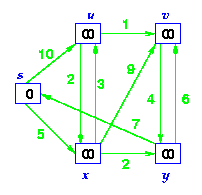
Step 2. First we choose the node, which is closest to the source node, s. We initialize d[s] to 0. Add it to S. Relax all nodes adjacent to source, s. Update predecessor (see red arrow in diagram below) for all nodes updated.

Step 3. Choose the closest node, x. Relax all nodes adjacent to node x. Update predecessors for nodes u, v and y (again notice red arrows in diagram below).
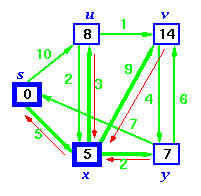
Step 4. Now, node y is the closest node, so add it to S. Relax node v and adjust its predecessor (red arrows remember!).
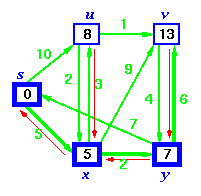
Step 5. Now we have node u that is closest. Choose this node and adjust its neighbor node v.
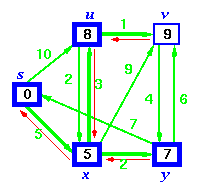
Step 6. Finally, add node v. The predecessor list now defines the shortest path from each node to the source node, s.
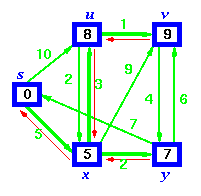
Q as a linear array
EXTRACT_MIN takes O(V) time and there are |V| such operations. Therefore, a total time for EXTRACT_MIN in while-loop is O(V2). Since the total number of edges in all the adjacency list is |E|. Therefore for-loop iterates |E| times with each iteration taking O(1) time. Hence, the running time of the algorithm with array implementation is O(V2 + E) = O(V2).
Q as a binary heap ( If G is sparse)
In this case, EXTRACT_MIN operations takes O(lg V) time and there are |V| such operations.
The binary heap can be build in O(V) time.
Operation DECREASE (in the RELAX) takes O(lg V) time and there are at most such operations.
Hence, the running time of the algorithm with binary heap provided given graph is sparse is O((V + E) lg V). Note that this time becomes O(ElgV) if all vertices in the graph is reachable from the source vertices.
Q as a Fibonacci heap
In this case, the amortized cost of each of |V| EXTRAT_MIN operations if O(lg V).
Operation DECREASE_KEY in the subroutine RELAX now takes only O(1) amortized time for each of the |E| edges.
As we have mentioned above that Dijkstra's algorithm does not work on the digraph with negative-weight edges. Now we give a simple example to show that Dijkstra's algorithm produces incorrect results in this situation. Consider the digraph consists of V = {s, a, b} and E = {(s, a), (s, b), (b, a)} where w(s, a) = 1, w(s, b) = 2, and w(b, a) = -2.
Dijkstra's algorithm gives d[a] = 1, d[b] = 2. But due to the negative-edge weight w(b, a), the shortest distance from vertex s to vertex a is 1-2 = -1.